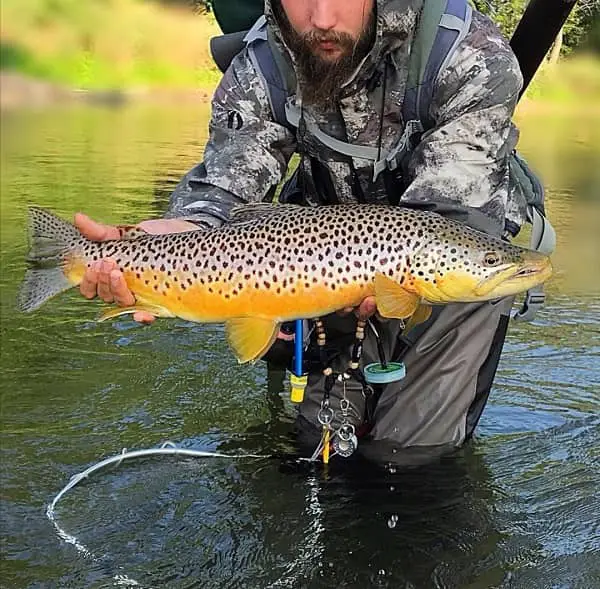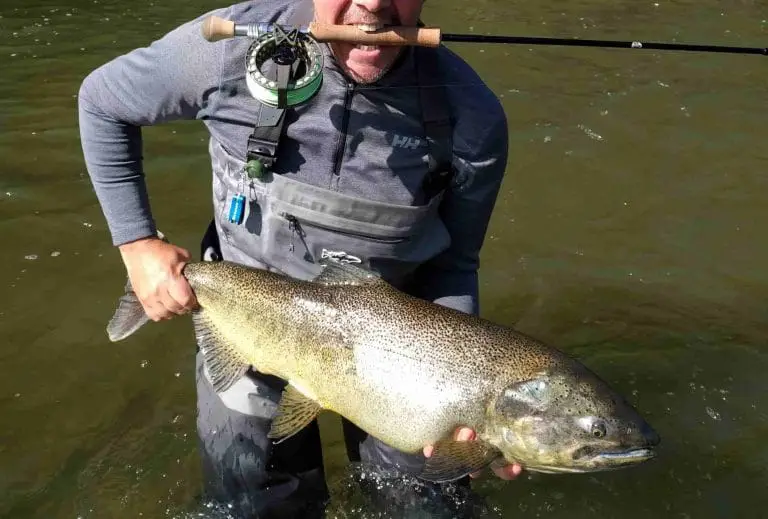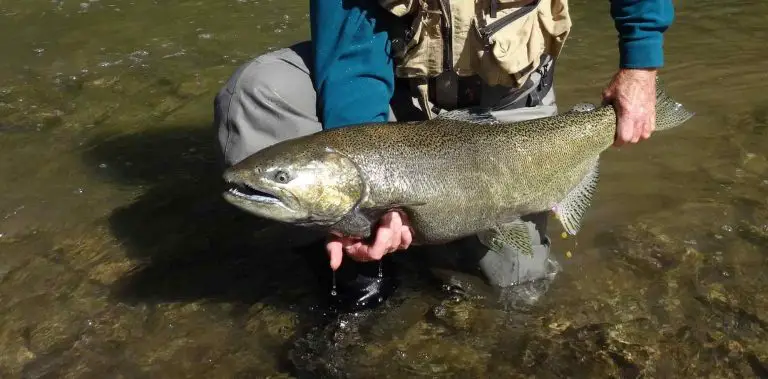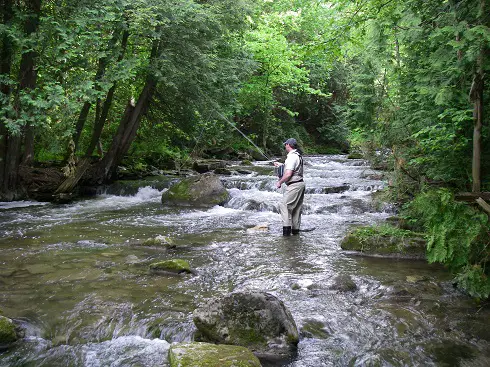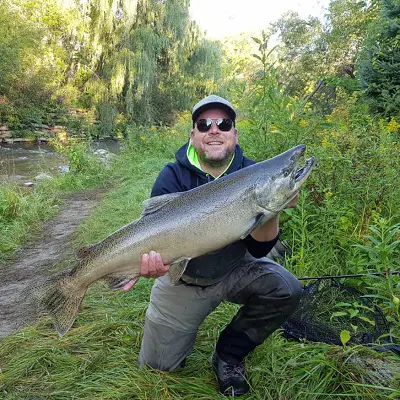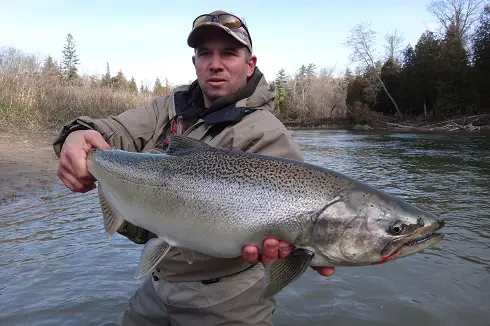Ontario Salmon Fishing – Tips And Advice From An Expert
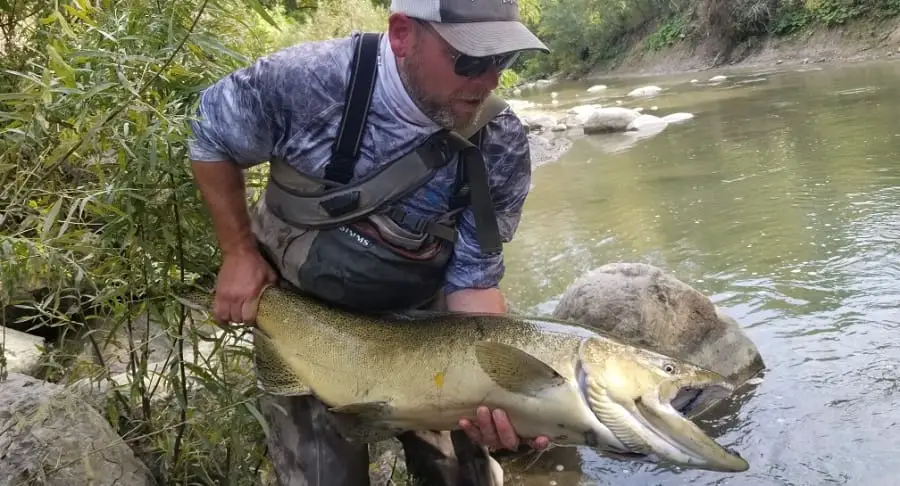
Ontario salmon fishing is popular in the fall but knowing where to go and what to use will greatly increase your chances of catching one of these massive salmon that can reach sizes of 40 pounds. I am the top river guide in Ontario and in this article, I will tell you where the salmon hot spots are and what methods I use to catch them.
Chinook Salmon, like the one in the above picture, is the most common of the four salmon species available in Ontario rivers. I will discuss all the different salmon species below. For many anglers, a huge salmon like this one is what fishing for Ontario Salmon is all about.
Knowing the best baits, the best lures, and what the best gear to use is will greatly increase your chances of catching these big fish. It’s also very helpful to know when and where to fish which will all be discussed below.
Ontario Chinook Salmon
Chinook salmon are the most sought-after Ontario salmon because of their large size and large numbers. Chinook salmon is also known as or referred to by the locals as, Chinnies, Chinooks, Nooks, King Salmon, or Kings.
Salmon are an introduced species in the Great Lakes, and they run up the rivers in the fall.
Salmon is the first species to enter the rivers in the fall and they are the largest. The fishing for salmon is usually best from mid-September to late October but once the salmon runs are over anglers switch over to steelhead fishing.
Ontario steelhead can be over 25 pounds and will run up the rivers from October to May. For more information about Ontario steelhead fishing check out my page Fishing For Ontario Steelhead: Tips and Advice From A Guide
These Chinooks can grow to over 40 pounds but they average between 15 and 25lbs on most rivers. Once hooked they sometimes feel like you’ve hooked the back of a boat that just won’t stop.
Some days it’s not uncommon for a few thousand salmon to enter the rivers giving anglers some spectacular fishing.
The Ontario Salmon Run
Watch some of the incredible footage of salmon running up the rivers in Ontario.
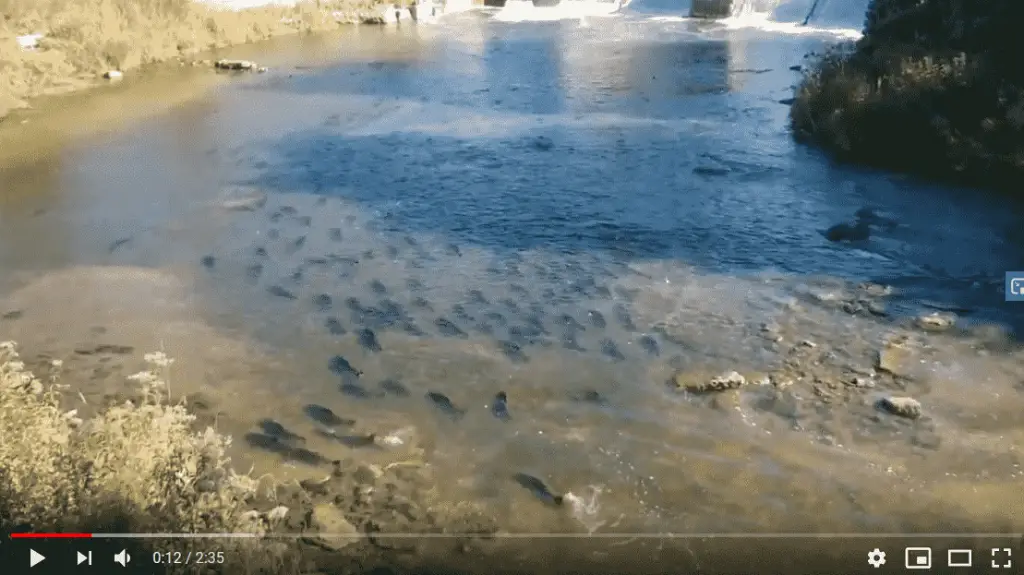
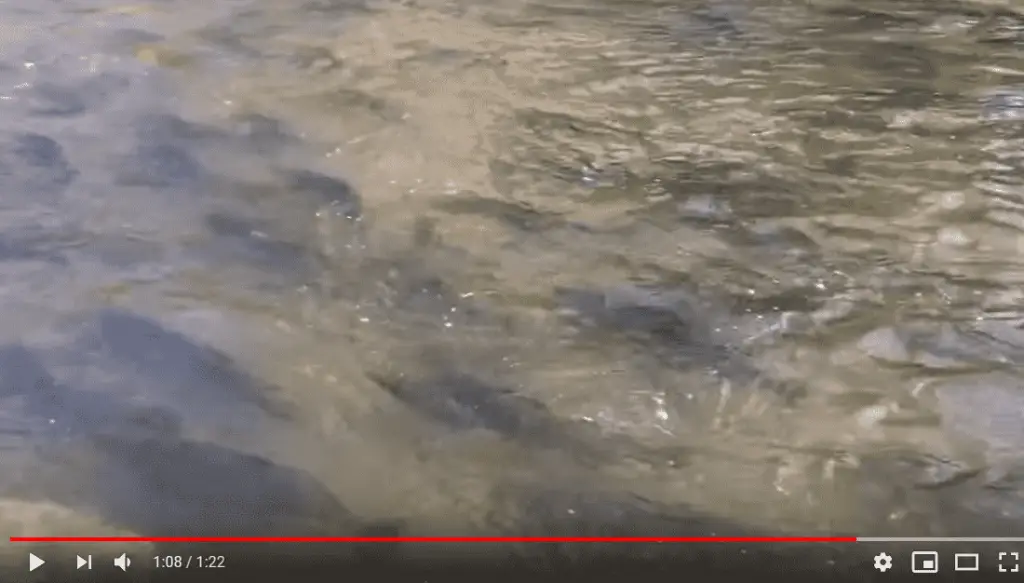
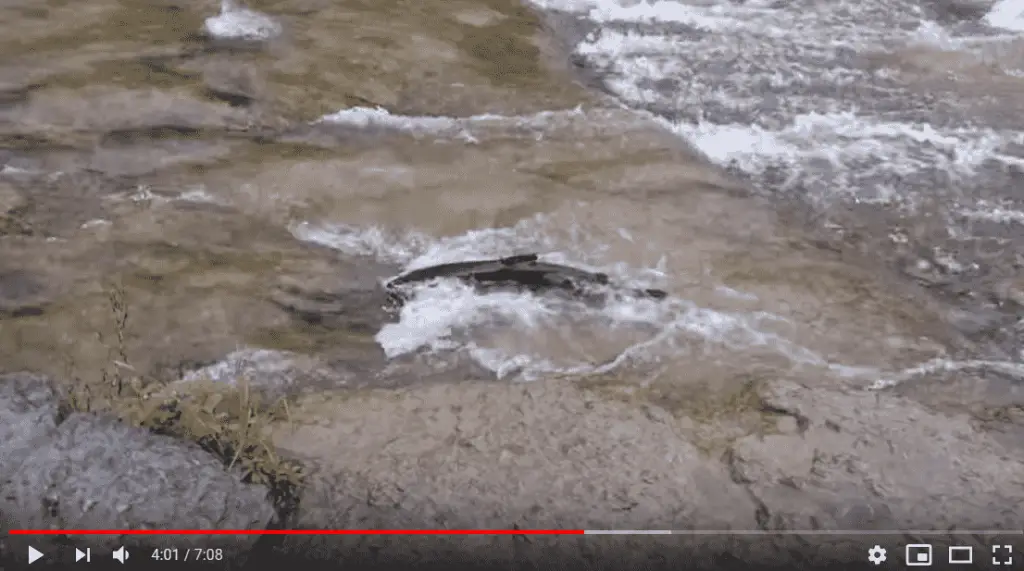
On most Ontario rivers, the salmon show up in good numbers in September. Fresh early September salmon that come straight in from the lake are silver, acrobatic, and one of the hardest fighting fish in Ontario.
After they stay in the river for a week or two they take on darker spawning colors and may get hooked jaws and can grow some large dog-like teeth.
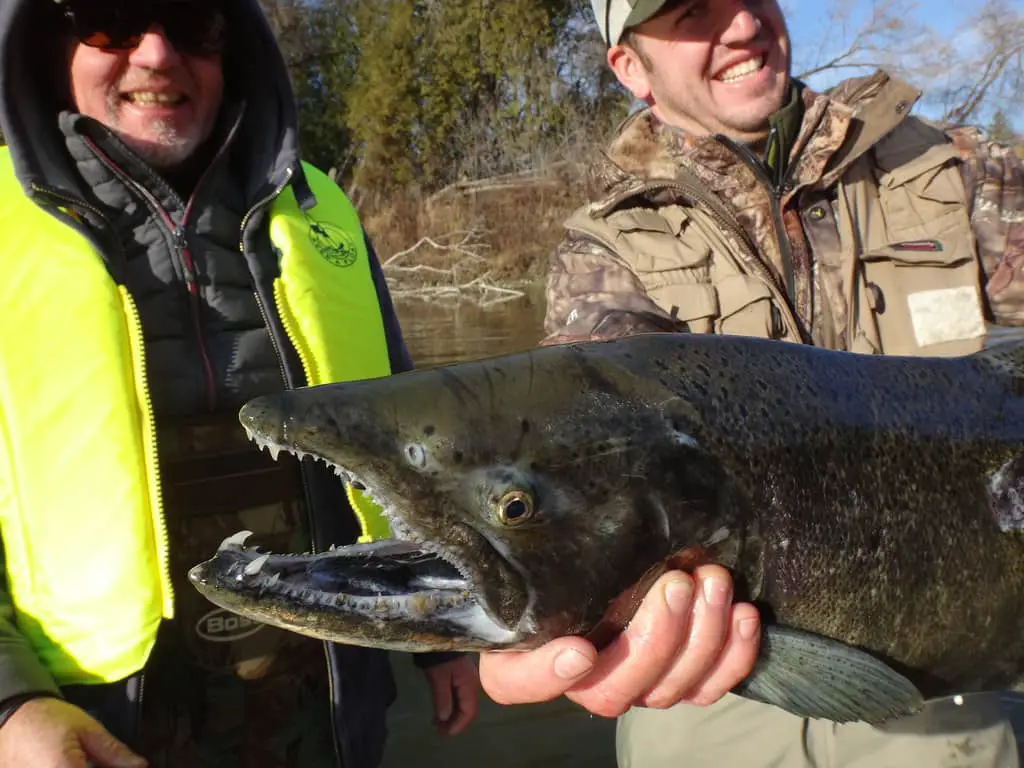
They can get pretty beat-up looking during the spawn with lots of scars, scraped off scales and skin, and they can turn almost black in color.
Salmon that have been spawning for days and in this beat-up condition do not fight very hard and are usually not worth fishing for.
Some guys will even call them old boots because you literally just drag them in with hardly any fight left in them.
Your chances are much better and the fight is better if you fish for salmon holding in the pools or ones that are slowly moving up the river.
Snagging is illegal in Ontario and most or all fish taken off the spawning beds are caught by snagging… Avoid the temptation, DON’T SNAG SALMON!
Other Ontario Salmon Species
Fishing for Ontario Salmon is not just about Chinook salmon.
Ontario has four salmon species which also include Coho Salmon, Pink salmon, and Atlantic salmon. These Ontario salmon species are in much smaller numbers, and timing the runs of these salmon can be hard, but if you use my advice below on timing the runs you may hit the salmon runs perfectly.
In southern Ontario, I rarely ever hear of Pink salmon being caught, and in 35 years have never caught one myself. Pink salmon are more common further north in the St.Mary’s river, and occasional catches have been reported in some Georgian Bay and Lake Huron rivers.
Ontario Coho Salmon
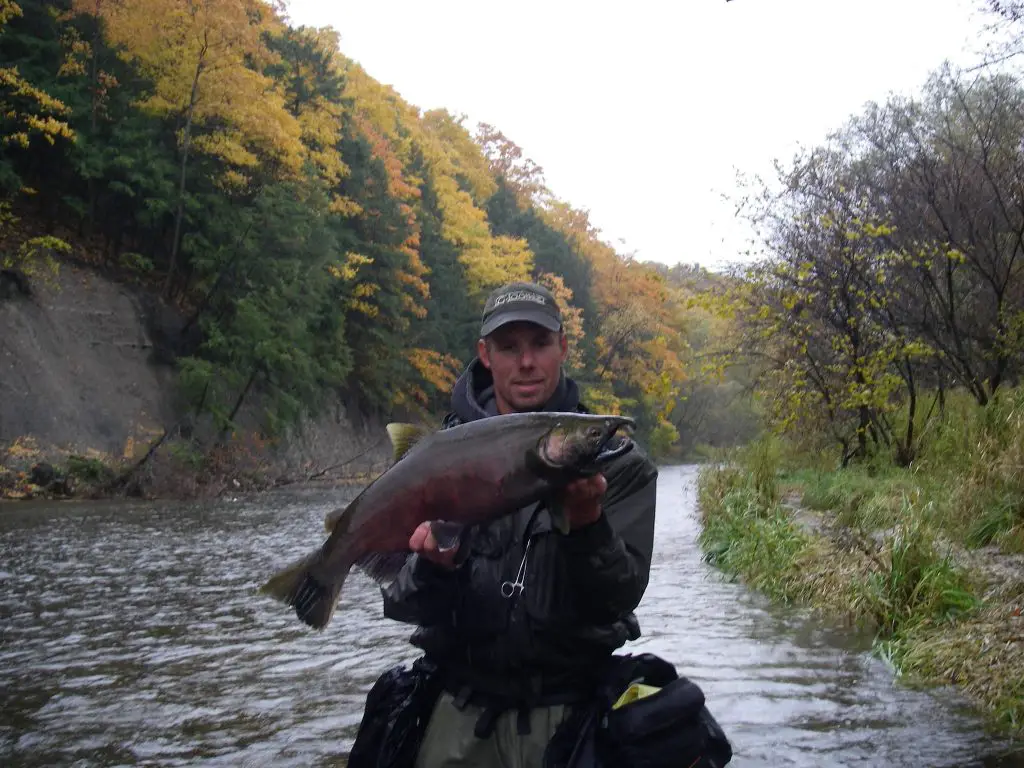
The Coho salmon are smaller than the Chinook salmon but they are known for their fast runs and plentiful jumping style of fight.
Ontario Coho Salmon start entering rivers in September and you can still find them in the rivers in November.
Ontario Coho salmon are primarily found in Lake Ontario rivers and they are very rare in Lake Huron, Lake Erie, and Georgian Bay Rivers.
Ontario Coho Salmon are often more brightly colored with hues of red, pink, purple, and orange.
Ontario Atlantic Salmon
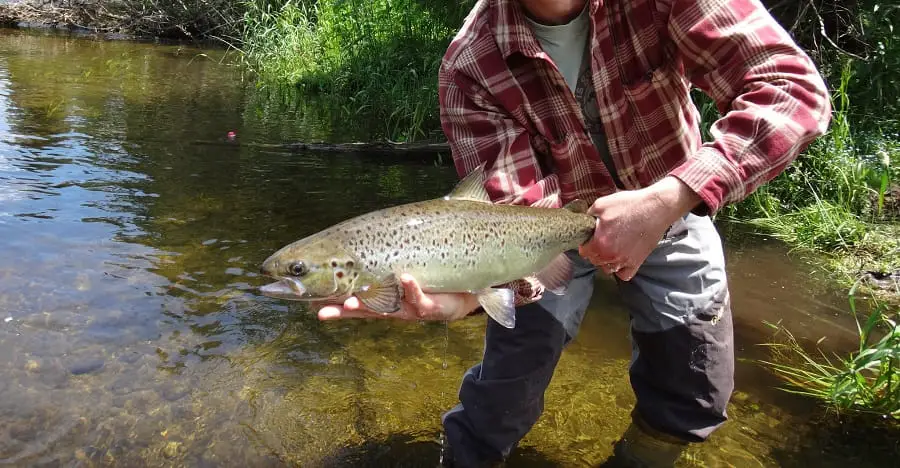
The Ontario OMNR, along with other groups such as the Ontario Federation of Anglers and Hunters, have been trying for about ten years to reintroduce Atlantic salmon to Lake Ontario and its Tributaries.
They have stocked tens of millions of Atlantic salmon in many of the best steelhead rivers, and some lucky anglers are catching some, but they are still a rare catch.
Unfortunately, considering the tens of millions of Atlantic salmon that have been stocked into Lake Ontario rivers and the time and effort involved, the numbers of adult Atlantic salmon returning to the rivers are extremely low with most anglers never catching even one.
If you want to try for Atlantic Salmon your best bet in southern Ontario is the Ganaraska River where the OMNR has put much of their recent efforts into stocking using a strain of landlocked Atlantic salmon.
A better option for fishing and catching an Ontario Atlantic Salmon in Ontario is to try the St. Mary’s River in Northern Ontario which is where they have been stocked by the USA and are actually returning in fishable numbers.
When Is The Salmon Run In Ontario?
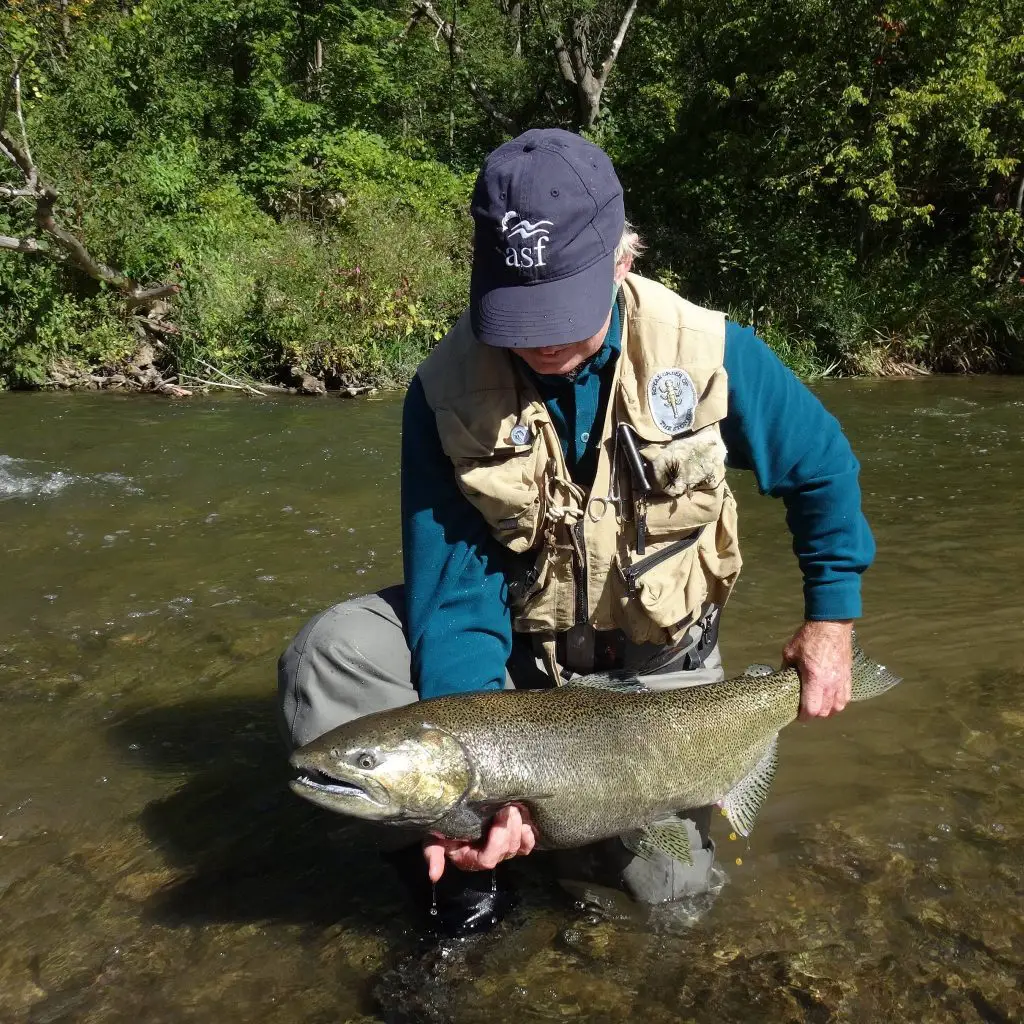
The salmon runs on some Ontario Rivers can start as early as August or even July, but starting this early is usually rare and the runs are often small and sporadic.
Most Ontario salmon enter the rivers in good numbers starting in September and through to late October. The runs usually occur after a significant rain brings up the water levels in the river.
The big Chinook salmon don’t normally like to enter the river when the water is super low because they are more exposed and also because it’s harder for them to swim through the shallow sections and rapids when the water is low so high water is preferred.
It’s also more common for the salmon to start their runs in the evening and overnight when it’s dark which is when they feel more comfortable moving in the shallower sections.
So even if it rains hard during the late morning the salmon might wait until almost dark before they start the run which means that the next morning can be great fishing and this is a good time to be on the river.
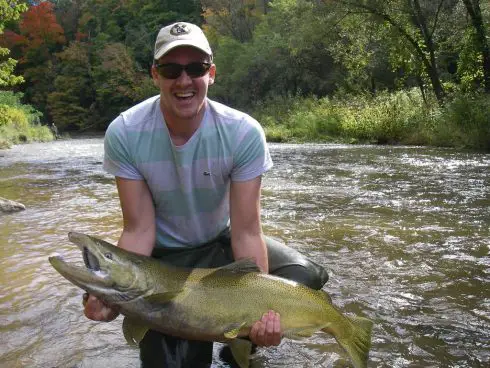
I tell my guide clients that they should head to the river 12 to 24 hours after the first big rain in September if they want a chance to hit the first good salmon run.
Each good rain after that should bring in some more salmon and colder nights mean colder water and that helps too.
If you hit the river 24 hours after the rain and it’s pure mud, the salmon can’t see your bait, so catching them is tough in those water conditions until the water starts to clear up.
If the water on one river is dirty try a smaller river that may clear up faster.
Instead of one big run, most years there could be dozens of small to medium-sized runs of salmon which come up the river after each rain. A small run might be 100 salmon and a large run could be over 5000 salmon. A run could last days with salmon entering the river over days.
If it’s a very dry year and there are no rains in September the salmon can enter the river at any time but, if there is a day when the winds are very strong and are blowing in-shore towards the river mouths and the river water is cold enough the salmon could enter the rivers at this time even if there is no rain and even if the river is very low.
The salmon will often hold off going up the river for as late as they can if there is no rain but the driving urge to spawn means they have to go even in the lowest of water.
The big salmon will sometimes need to swim through water so low that their backs are out of the water, and they drag their bellies across the rocks, which often rubs the scales off their bellies.
Trying to catch them in this super low water is useless since they never bite there. It’s best to find the next deep spot above the rapids where they will slow down and rest and fish for them there.
When Do The Salmon Spawn In Ontario? – Spawning Salmon
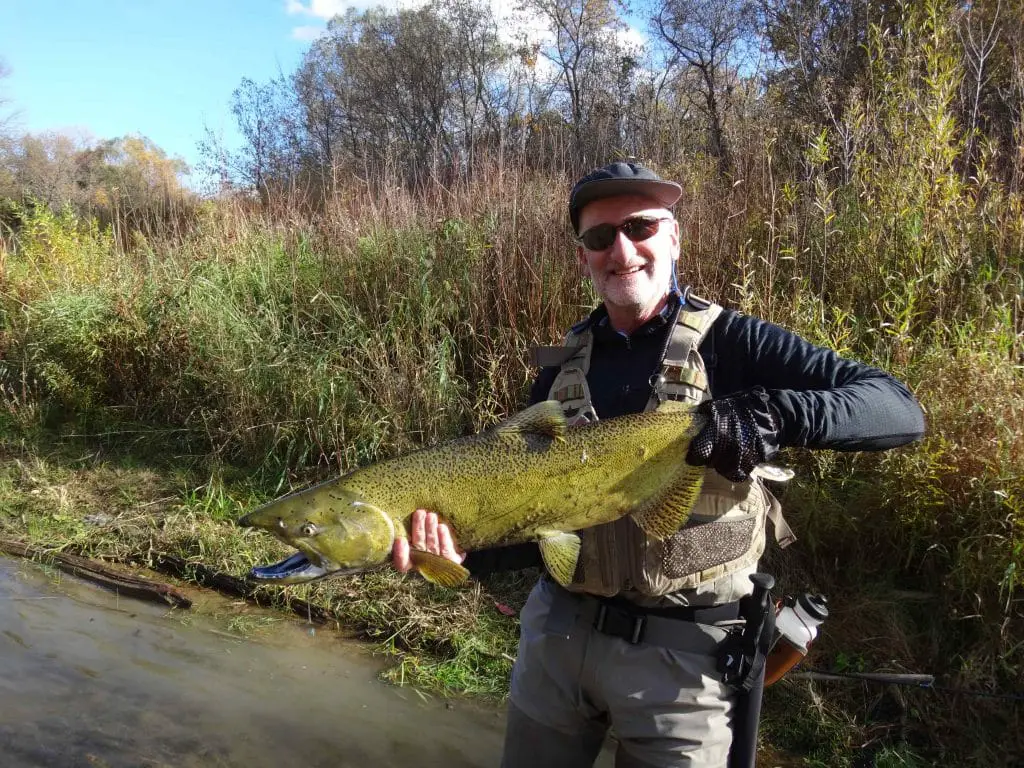
Some salmon will start spawning days after they enter the river.
Once they have gone far enough up the river into suitable spawning habitat and they have found a mate they will start their spawning ritual.
They can often spawn in multiple spots and with multiple partners.
Once the salmon get into the shallow water much further up the river and start spawning they normally won’t eat or hit your bait and it is recommended to not fish for the fish on the spawning beds.
The salmon are also expending a lot of energy while they are spawning so they don’t fight well. It’s best to let them spawn and make more salmon for years to come.
Do All Salmon Die After They Spawn?

All Pacific Ocean salmon such as the Chinook, Coho salmon, and pink salmon die after they are finished spawning.
Atlantic salmon are from the Atlantic Ocean and they may be able to spawn multiple times over many years.
Why Do Salmon Die After They Spawn?
The reason the Chinook and Coho salmon die after they spawn is that it is part of their natural life cycle and it benefits their young.
The rotting flesh of the dead salmon provides nutrients to the river, and that flesh may be eaten, and it can provide valuable nutrients for new young salmon.
The flesh of the salmon can also be eaten by the aquatic insects which are also eaten by the young salmon.
Because the adult salmon die and do not return to the ocean, it means more baitfish in the ocean or great lakes for the young salmon to eat.
The death of the salmon helps to ensure a better survival of their young offspring and a strong life cycle.
Do Salmon Eat Once They Enter The River?
Although it’s been said for many years that once the salmon enter the rivers they stop eating, some new research on salmon suggests what I’ve been saying for years, and that is that some salmon do eat during the spawn.
Even though they may not eat out of hunger, they may hit a fly or a lure or bait out of habit, or instinct, or aggression, and there are days when anglers will catch many salmon.
Whatever the reason is, it has been confirmed that some do eat even after they have been in the river for a while.
I’ve been fishing for Ontario Salmon for over 35 years, and I’ve seen 30lb salmon swim halfway across the pool to smash a fly or a roe bag, and I have had them hit spinners, spoons, and minnow lures with hard aggressive, and deliberate strikes. I’ve even had large adult salmon rise up to the surface and inhale my float or indicator.
The Best Baits For Ontario Salmon
Now that you know that salmon will eat when they enter the river you will need to know what the best methods are and what the best baits are.
The 4 best baits for fishing salmon in Ontario rivers are the plastic worm, the spawn bag, the trout bead, and the fly. These baits come in different sizes and colors and should always be fished using the right methods with perfect presentations.
It’s normal to see guys using the right baits, but they still don’t catch any fish. The simple truth and I know this for a fact after guiding over 3000 anglers, is that guys make mistakes in their leader setup, or they use the wrong gear, or they don’t know how to present the bait properly to make the salmon want to eat their bait, or all of the above.
If you want to know my tips on the best baits, how I set up my leaders, and how to fish the baits better check out my article Best Baits For Salmon Fishing On Rivers And When To Use Them. See at www.troutandsteelhead.net
What Are The Best Salmon Rivers In Ontario?

Just about every river and every creek flowing into Lake Ontario, Lake Huron, and Georgian Bay have runs of salmon. Some runs will be small and some large with over 10,000 salmon.
Normally, the larger the river, the bigger the salmon runs will be, but some smaller rivers can be thick with salmon in the fall.
Also, stocked rivers and the coldest, cleanest rivers with a high survival rate for young wild salmon will have bigger runs of salmon.
As far as the best salmon river in Ontario goes, it really depends on a few things.
Some anglers prefer smaller rivers and creeks that are 10 to 20 feet wide because they are often colder, and the salmon runs start earlier, and also because the salmon concentrate in the smaller pools so they are easier to hook.
The downside to these smaller rivers is they can be more crowded and have more wood and log jams so you may lose more salmon and they can be more difficult to land. Also, sometimes the pools are so small the salmon don’t have as much room to run, jump and fight.
Larger Ontario Salmon Rivers
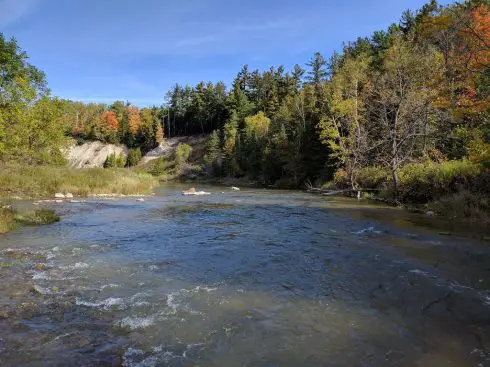
Larger salmon rivers can have the biggest runs of Ontario Salmon and are often the best choice for fishing Ontario salmon. Rivers Like the Credit River, Humber River, and Niagara River are great options.
Some of the bigger rivers can get very crowded at times but for anglers that are willing to explore and get away from the crowds, there are often miles of open water in September to fish where there are a lot fewer people.
The upside to fishing for salmon in these bigger rivers is that the pools are much bigger and deeper and fighting salmon in the bigger pools is way more fun.
I find salmon tend to jump more if the water is deeper and they are less likely to leave the pool and run up or down the river as far if the pool is bigger and deeper.
The Niagara River is the largest salmon river in Ontario and gets large runs of hard-fighting salmon.
What Are The Best Salmon Rivers Near Toronto?
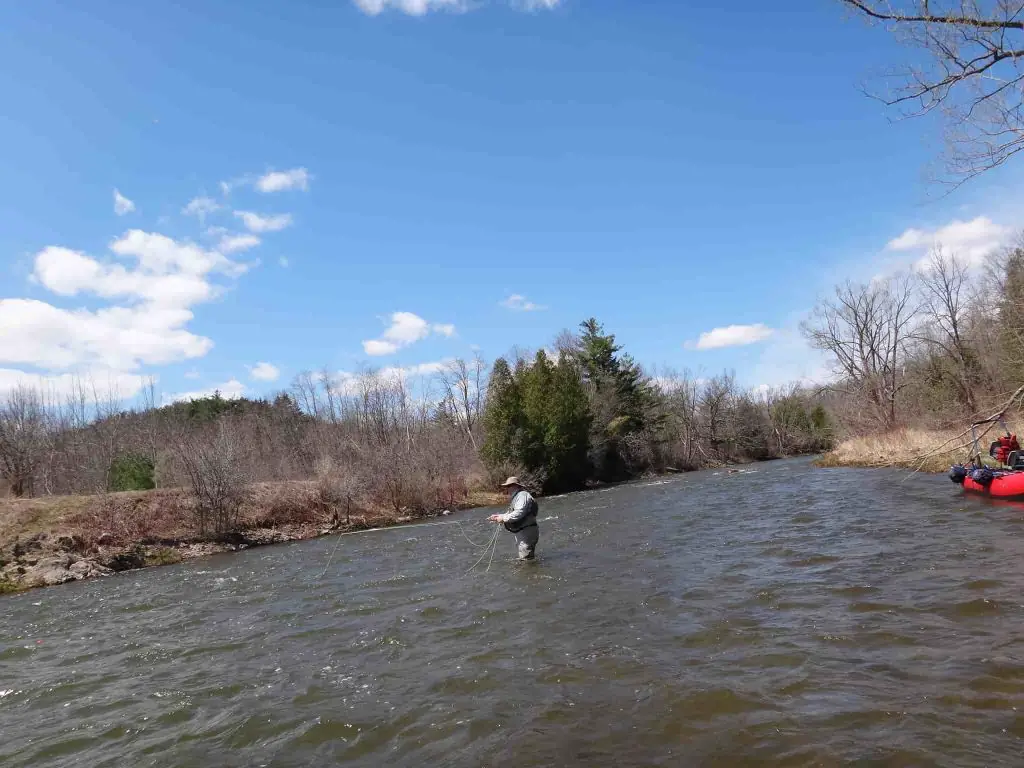
The 4 best salmon rivers within a short drive of Toronto are the Humber River, the Credit River, Bronte Creek, and Duffins Creek.
Almost in downtown Toronto is the Humber River and it gets a good run of Salmon starting in September.
Etobicoke Creek and the Don River will also get a small runs of salmon with very little crowds.
West of Toronto you could try the Credit River between Hwy 403 and the mouth. This river gets some of the biggest runs of salmon in Ontario.
Further West, you could try Oakville Creek, 16 Mile Creek, and a favorite for many is Bronte Creek. These rivers are normally low in September low so it sometimes takes a big rain to bring in the salmon.
East Of Toronto is a number of good rivers to try and fish for salmon but most of them are on the smaller side and they average about 15 feet wide. The Rouge River, Duffins Creek, and Oshawa Creeks are the closest to Toronto and are popular with salmon anglers.
You could also try further west on Bowmanville Creek, Wilmot Creek, and Grahams Creek.
Fishing For Salmon on the Ganaraska River
The Ganaraska River in Port Hope is one of the biggest rivers east of Toronto and it gets one of the largest runs of salmon from the eastern Lake Ontario tributaries. It also gets very crowded near the mouth of the river.
This is a good river if you just want to go watch the salmon run up the river and try to jump the dam at the Conservation area in Port Hope.
Anglers have the option to fish for the salmon in many areas from Sylvan Glen Park down to the mouth of the river.
For access points and where to view and fish the salmon see the section on fishing the Ganaraska river on my page Ontarios Best Rivers. That page also has good information on access to many other great rivers including the ones listed below.
Georgian Bay Salmon Fishing

Georgian Bay has numerous cold clean rivers that have runs of Ontario salmon. Some of the best rivers are the Nottawasaga River, the Beaver River, The Bighead River, and the Sydenham River.
Just about every river and creek flowing into Georgian Bay from the town of Waubeshene to the town of Tobermory will have salmon in them.
Further north on Georgian Bay there are not many rivers suitable for salmon fishing but some anglers report salmon in Parry Sound River, Magnetawan River, and the Severn River in Port Severn.
On the eastern side of Georgian Bay, anglers could try fishing the Cold Water River near the town of Cold Water, as well as the Sturgeon River and Hoggs River near Midland, which also gets small runs of salmon.
The Nottawasaga River, the Beaver River, and the Bighead River also get good runs of Salmon.
Further west on Georgian Bay, anglers can try the Sydenham River, Colpoys Creek, and the Pottawatomi Rivers for salmon
Lake Huron Salmon Fishing
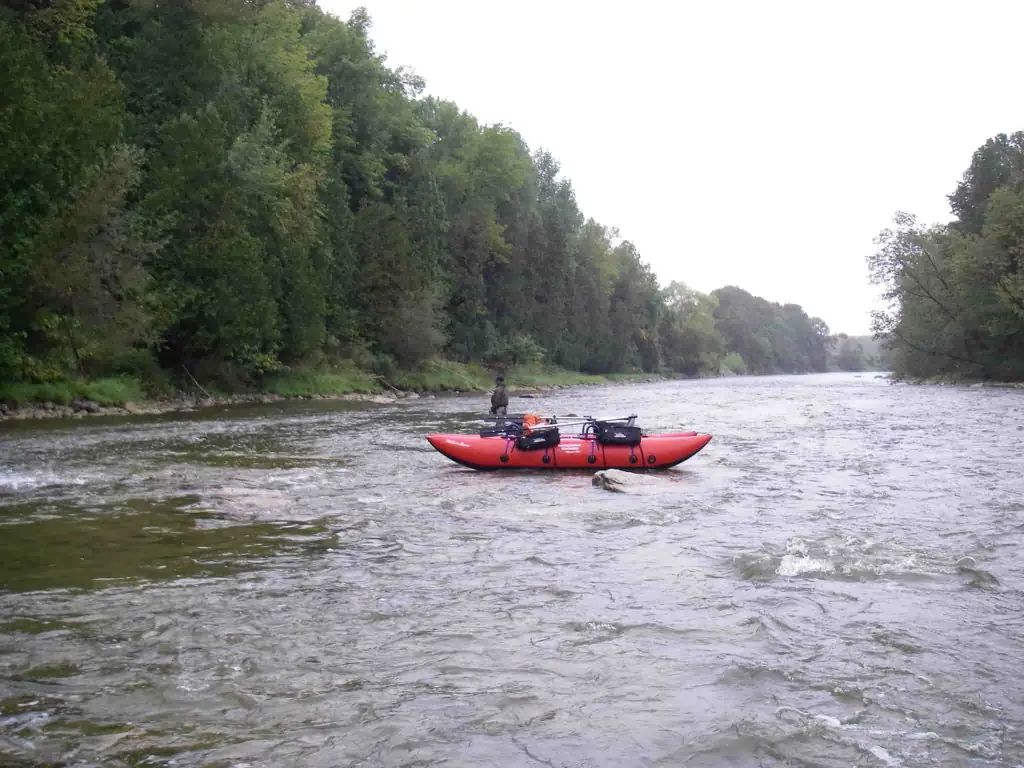
Lake Huron has over a dozen rivers and creeks that get runs of Ontario Salmon. The best Lake Huron Salmon rivers are the Saugeen Rivers, the Sauble River, the Maitland River, and the Bayfield River.
Lake Huron rivers tend to get a lot less salmon than the Lake Ontario rivers do.
The largest salmon river and maybe the most well known is in the town of South Hampton and is called the Saugeen River.
Most anglers here fish the area known as Denny’s damn in the Dennys Dam Conservation Area and down the river towards the mouth of the river. This section of the river is open year-round and is popular for steelhead as well.
Salmon on this river can get up past the town of Walkerton giving anglers lots of room to fish for them. Popular spots on this river to fish are in the town of Paisley and in the Saugeen Bluffs Provincial Park.
Anglers can also try the Sauble River, The Penetangore River, the Maitland River, 9 Mile River, and the Bayfield River for fall salmon.
Lake Erie Salmon
Lake Erie does not have any substantial stocking of salmon on the Ontario Side and gets little to no salmon runs in the rivers.
However, there are some incidental catches of salmon that may be coming from Lake Huron or from the small amount of salmon that might be stocked on the USA side.
More Ontario Salmon Rivers
Most of the steelhead and trout rivers that I discuss on the Ontario Rivers page also get runs of salmon and you can find more details about each river there, so I recommend that you check out that page for more ideas on where to try the next time you want to go fishing for Ontario salmon.
The Best Time To Fish For Ontario Salmon?
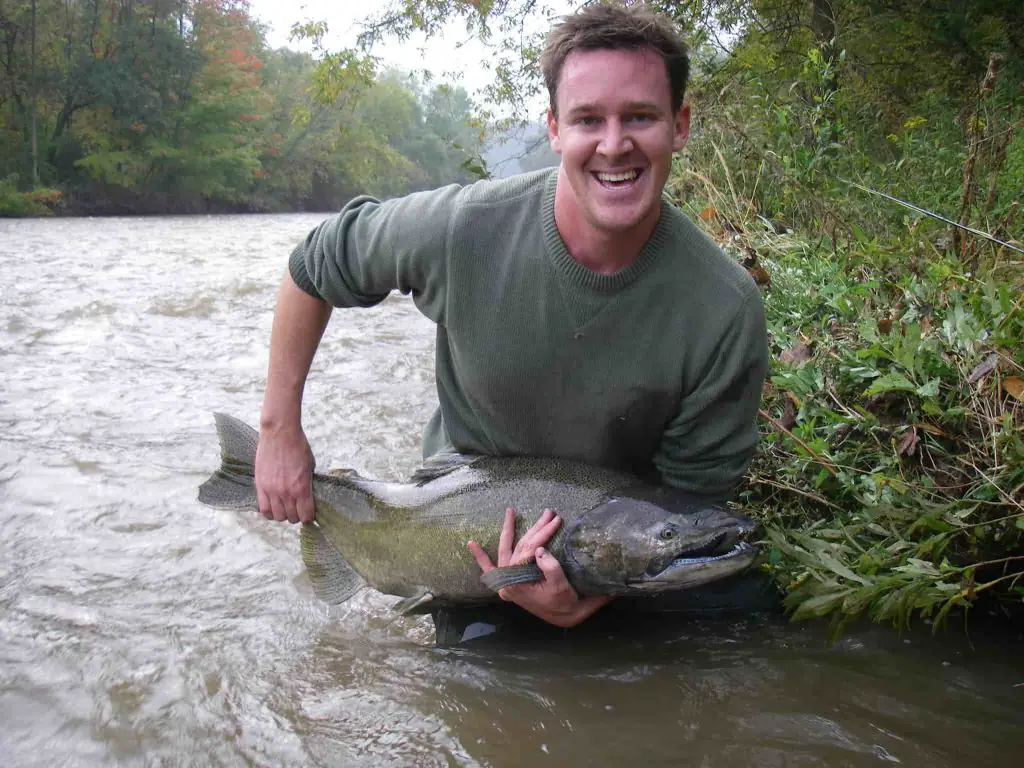
Hard fighting, acrobatics, and lots of salmon keep guys coming back for more but when is the best time to fish for Salmon in Ontario and around the Great Lakes?
The salmon season on most rivers ends on September 30th with the closing of the trout season, however, there may be extended seasons and year-round seasons available on some rivers.
It’s best to check the Ontario Fishing Regulations if you want to try fishing for Ontario salmon after September 30th.
I have already discussed the timing of the salmon runs and the seasons for salmon, but to beat the crowds and to have the best day on the water fishing for salmon I recommend that you try fishing mid-week during September and October or take a riverboat guided trip through less pressured water. A Perfect Drift Guide Company guides for salmon in the fall
The weekends are always the most crowded and the worst time to fish on many of the more popular rivers.
Fishing For Ontario Salmon
There are many ways to catch salmon in Ontario, some are good, and some are not so good. Float fishing is one of the most productive ways to catch salmon once they enter the rivers.
It’s important to use the right rods, the right lines, floats, and baits if you want to catch the most salmon possible.
There are other methods that work great for Ontario salmon fishing like fly fishing for salmon, Centerpin fishing for salmon, and casting lures for salmon. I will discuss those methods below.
Fly Fishing For Ontario Salmon
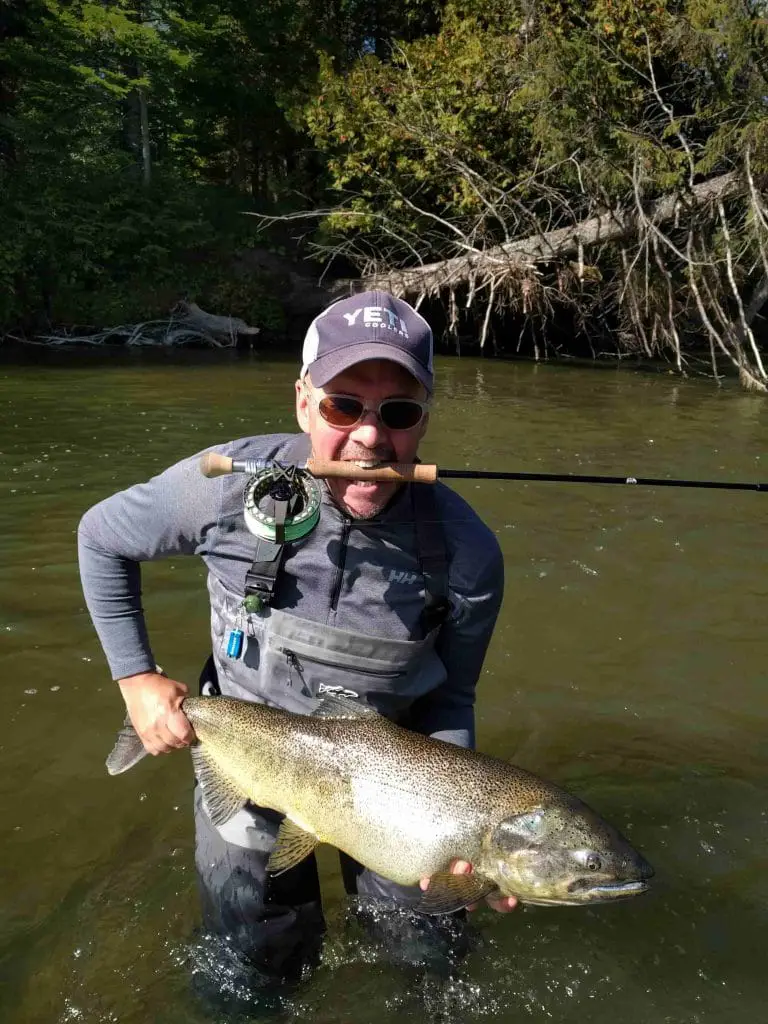
Fly fishing for Ontario Salmon can be one of the most fun and the most productive ways to catch these great fish once they enter the river.
Some anglers choose to use indicators and nymph for them the same way they do with steelhead and trout and this is often the most productive way to catch Ontario Salmon.
Go to my Fly Fishing For Salmon page for a lot more detailed information on fly fishing for Great Lakes salmon.
Spey Fishing For Ontario Salmon
Spey fishing for Ontario salmon or also known as swinging flies in front of salmon can be very productive and very rewarding.
Salmon can be aggressive and they will hit a well-presented fly that is presented close to them. Some salmon will chase the fly across the river before they eat it, which gives spey angler quite the thrill.
Euro Nymphing For Ontario Salmon
A new fly fishing method that anglers are starting to do is Euro-style nymphing for salmon and this method is also very productive. The guides at A Perfect Drift Guide Company specialize in all of these methods.
Float Fishing For Salmon
Float fishing is the most common way to fish for salmon in Ontario and is the most productive way to catch these salmon if done right with the right lines, the right rods and reels, and the right baits.
I have had days of over 50 salmon hooked and landed using my float fishing methods which you can see on my page.
Float fishing is most commonly done using spinning reels or Centerpin reels, and if done right with the right leader setup you can catch a lot more salmon.
I discuss my best methods and show you my best salmon leader setup and the best baits for Ontario salmon on my page Float Fishing For Ontario Salmon.
Centerpin Fishing For Ontario Salmon
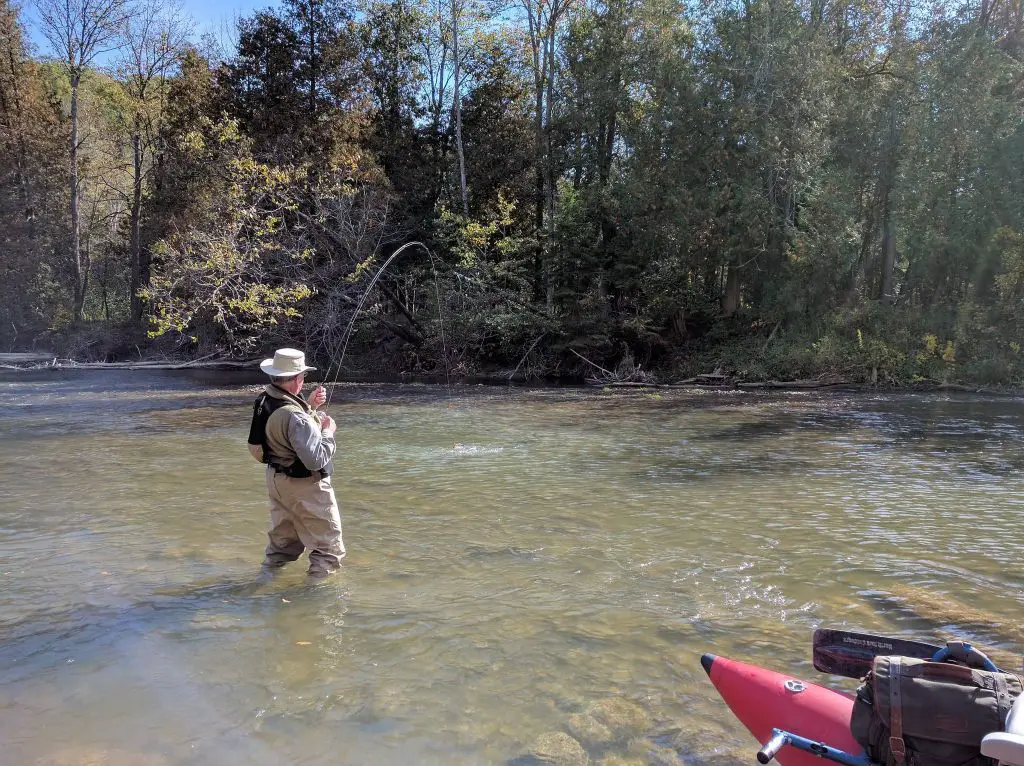
Salmon anglers fishing for Ontario salmon also use Centerpin reels and rods the same way they Centerpin for steelhead. Centerpin Fishing is also known as float fishing.
Go to my Centerpin Fishing page for more information for a lot more detailed information on Centerpin fishing rivers in the great lakes region.
For more in-depth and detailed information about the best baits, the best gear, and the best for salmon fishing like my leader setup, tips on how to float fish, and more check out my Float Fishing For Ontario Salmon.
Spin Fishing For Ontario Salmon – Lures
Spin fishing for Ontario salmon consists of a spinning reel and a spinning rod and using lures, bait, or floats.
Once they enter the river, their primary goal is to get as far up the river as they can to spawn, so getting them to bite your lure can be tough, but . . . .
Salmon like shiny or bright things and they like a lot of action in the lures
When spin fishing some anglers prefer to throw lures like Flatfish, Kwikfish, spinners, or minnow-style lures like Rapalas. I often use the same baits for salmon as I do for steelhead with a few exceptions. For the best salmon baits that I use check out my article Best Lures And Guide Tactics When Fishing Lure For Salmon In Rivers. See at www.troutandsteelhead.net
The guides at A Perfect Drift Guide Company say their favorite and often most productive spin fishing method is to cast Mepps, Vibrax, or Panther Martin spinners across and slightly downriver reeling only fast enough to keep the blades spinning while trying to keep the lures two to three feet off the bottom.
If a strike doesn’t happen on the first cast they try a faster retrieve and or a more erratic stop and go type retrieve to entice a strike. If that doesn’t produce they cast 3 to 5 feet down the river and repeat until they have success.
This method can be used with most lures. Sometimes changing colors and lures can be the key to triggering the salmon to strike. The strikes are usually aggressive so be prepared. Note: It is illegal and unethical to purposely snag salmon in Ontario.
Make sure you use the right gear for salmon. You can see what I recommend on my page Best Gear For Great Lakes Salmon Fishing
A 9 to 11-foot medium action rod is a good choice for throwing lures.
Some anglers also drift roe, worms, minnows, plastic baits, artificial flies, and small marshmallows underneath steelhead floats which can all be very productive.
Bottom bouncing is another method that works providing the angler is good enough to detect strikes. This takes practice but if you get good at it, it can produce a lot of fish. Not sure how to bottom bounce, check out my advanced bottom bouncing methods here – Bottom Bouncing – 5 Proven Guide Tips For More Fish. See at www.troutandsteelhead.net
Double header days and days of 50 to 100 hookups are possible if you know what you are doing and you time the runs perfect. It’s not uncommon to do a trip with the guides from A Perfect Drift Guide Company and see over 50 Salmon a day.
Best Salmon Gear for Ontario Salmon
Even if there are large numbers of salmon in the river, if you don’t have the right gear then fishing for Ontario salmon can be tough.
I’ve seen many rods broken and many fish lost because guys fish with the wrong gear. I have also seen guys catching no fish because they are using the wrong gear, the wrong set-up, and the wrong baits.
When fishing for Ontario salmon anglers can use multiple methods and different gear for catching river salmon so I talk about the gear I use and the best lures, best baits, and best set-ups for each method on the Best Salmon Gear Page – HERE.
Can You Eat The Salmon In The River
If you catch the salmon within a day or 2 of entering a river they may be suitable to eat.
They say that once the salmon enters the river their bodies go through changes and this causes the meat of the salmon to become softer and not as firm and therefore once they start to get too dark and beat up it is not advised to eat them.
If they have been in the river too long, most anglers find they do not taste as good and the texture of the meat isn’t as good as if it was caught in the lake.
How To Fish For Salmon – Guide Tips And Tactics
If you want more detailed information on how to fish for salmon, which includes the best methods that I use for salmon fishing as well as how to fish for salmon with lures, and my most effective lures, check out my article How To Fish For Great Lakes Salmon in Rivers: Guide Tactics. See at www.troutandsteelhead.net
Common But Illegal Fishing For Ontario Salmon
It is illegal to snag salmon. Snagging means hooking the salmon in any part of the body that is not in the mouth.
Unfortunately, some anglers like to wait in shallow sections and rapids that are about 12 to 20 inches deep and wait for the salmon to swim up and once they see the salmon they grab their 7-foot rod with 30-pound test and their giant treble hooks and they start repeatedly swinging that hook at the salmon until they snag the salmon.
THESE GUYS ARE FISHING MORONS AND THEY ARE FISHING ILLEGALLY!
If these guys just took the time to learn how to fish for salmon the right way, they would probably catch 10 times more salmon, and they would be doing it legally.
Snagging is illegal in Ontario! Please don’t be a salmon snagging moron, there is no need for it since there are much better and legal ways to catch salmon.
While the salmon snagging morons are on the water catching 1 or 2 if they are lucky, I’m hooking 10 to 30 legally using skill and the right baits.
Use the methods and the gear I describe above and you will catch far more fish than you would snagging them.
Ontario Salmon Fishing
Ontario Salmon fishing can be great if you know where to go, what to use, and how to fish for them effectively. I hope that this page really helps you catch some more big salmon.
Graham

